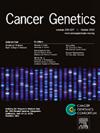利尿原素通过调控sting - 1抑制膀胱癌细胞增殖和迁移的机制研究
IF 2.1
4区 医学
Q4 GENETICS & HEREDITY
引用次数: 0
摘要
膀胱癌(BLCA)是泌尿系统最常见的恶性肿瘤,男性的发病率明显高于女性,严重影响生活质量。STING1基因(干扰素基因1的刺激因子)通过识别异常DNA,激活免疫信号通路,促进I型干扰素和促炎细胞因子的表达,从而增强抗肿瘤免疫应答,在先天免疫中发挥关键作用。甘草素(Liquiritigenin, LQG)是一种从甘草中提取的类黄酮化合物,具有抗炎、抗氧化和抗癌的特性,能够抑制肿瘤细胞的增殖和侵袭,同时调节自噬。本研究旨在探讨LQG在膀胱癌中调控STING1基因的作用及其抗癌机制。方法采用多维度研究方法,结合生物信息学分析和体内外实验验证。利用生物信息学方法评估STING1基因的表达、功能和免疫相关分析。体外实验包括CCK-8测定和集落形成测定,以评估细胞增殖;跨井迁移试验和伤口愈合试验,以评估迁移能力;流式细胞术分析细胞凋亡;免疫荧光法观察自噬体的积累情况。此外,通过分子对接分析来探索LQG与STING蛋白之间的相互作用,并利用Western blotting来阐明关键的分子途径。体内研究采用小鼠异种移植肿瘤模型,系统评价LQG的抗肿瘤作用和安全性。结果结果显示,与正常组织相比,膀胱癌组织中STING1的表达明显降低。功能富集分析表明,STING1与免疫应答调节密切相关。高表达与不同类型的免疫细胞和重要的免疫检查点呈正相关。免疫治疗分析表明,高表达的STING1与良好的临床反应相关。分子对接证实LQG直接靶向STING蛋白。实验结果表明,LQG通过靶向STING,阻断自噬通量抑制肿瘤细胞存活。此外,LQG下调MMP2和MMP9的表达,抑制迁移和侵袭,同时通过调节Bcl-2、Bax和caspase-3水平促进细胞凋亡。结论这些发现强调了STING1在膀胱癌免疫生物学中的重要作用,表明其有潜力作为免疫治疗的靶点和生物标志物。新型STING激动剂LQG具有多种抗肿瘤作用,包括调节细胞凋亡、抑制侵袭、增强免疫应答等。这为未来sting靶向治疗膀胱癌铺平了道路。本文章由计算机程序翻译,如有差异,请以英文原文为准。
Mechanistic study of Liquiritigenin inhibiting bladder cancer cell proliferation and migration by regulating STING1
Background
Bladder cancer (BLCA) is the most common malignant tumor in the urinary system, with a significantly higher incidence in men than in women, severely impacting quality of life. The STING1 gene (stimulator of interferon genes 1) plays a critical role in innate immunity by recognizing abnormal DNA and activating immune signaling pathways, promoting the expression of type I interferons and pro-inflammatory cytokines, thereby enhancing anti-tumor immune responses. Liquiritigenin (LQG), a flavonoid compound extracted from licorice, exhibits anti-inflammatory, antioxidant, and anti-cancer properties, capable of inhibiting tumor cell proliferation and invasion while regulating autophagy. This study aims to evaluate the role of LQG in regulating the STING1 gene and its anti-cancer mechanisms in bladder cancer.
Methods
This study employed a multidimensional approach, combining bioinformatics analysis with both in vitro and in vivo experimental validation. Bioinformatics was utilized to assess the expression, function, and immune-related analyses of the STING1 gene. In vitro experiments included CCK-8 assays and colony formation assays to evaluate cell proliferation; Transwell migration assays and wound healing assays to assess migratory capacity; flow cytometry to analyze apoptosis; and immunofluorescence to observe the accumulation of autophagosomes. Additionally, molecular docking analysis was conducted to explore the interaction between LQG and the STING protein, while Western blotting was used to elucidate key molecular pathways. In vivo studies employed a mouse xenograft tumor model to systematically evaluate the anti-tumor effects and safety of LQG.
Results
The results showed that STING1 expression was significantly lower in bladder cancer tissues compared to normal tissues. Functional enrichment analysis indicated a close relationship between STING1 and immune response regulation. High STING1 expression was positively associated with different types of immune cells and important immune checkpoints. Analysis of immunotherapy indicated that high STING1 expression was associated with favorable clinical responses. Molecular docking confirmed that LQG directly targets the STING protein. Experimental results demonstrated that LQG inhibits tumor cell survival by targeting STING and blocking autophagic flux. Additionally, LQG downregulated the expression of MMP2 and MMP9, inhibiting migration and invasion, while enhancing apoptosis by modulating Bcl-2, Bax, and caspase-3 levels.
Conclusion
These findings underscore the critical role of STING1 in the immunobiology of bladder cancer, indicating its potential as a therapeutic target and biomarker for immunotherapy. The novel STING agonist LQG has multiple anti-tumor effects, including the modulation of apoptosis, inhibition of invasion, and enhancement of immune responses. This paves the way for future STING-targeted therapies in bladder cancer treatment.
求助全文
通过发布文献求助,成功后即可免费获取论文全文。
去求助
来源期刊

Cancer Genetics
ONCOLOGY-GENETICS & HEREDITY
CiteScore
3.20
自引率
5.30%
发文量
167
审稿时长
27 days
期刊介绍:
The aim of Cancer Genetics is to publish high quality scientific papers on the cellular, genetic and molecular aspects of cancer, including cancer predisposition and clinical diagnostic applications. Specific areas of interest include descriptions of new chromosomal, molecular or epigenetic alterations in benign and malignant diseases; novel laboratory approaches for identification and characterization of chromosomal rearrangements or genomic alterations in cancer cells; correlation of genetic changes with pathology and clinical presentation; and the molecular genetics of cancer predisposition. To reach a basic science and clinical multidisciplinary audience, we welcome original full-length articles, reviews, meeting summaries, brief reports, and letters to the editor.
 求助内容:
求助内容: 应助结果提醒方式:
应助结果提醒方式:


